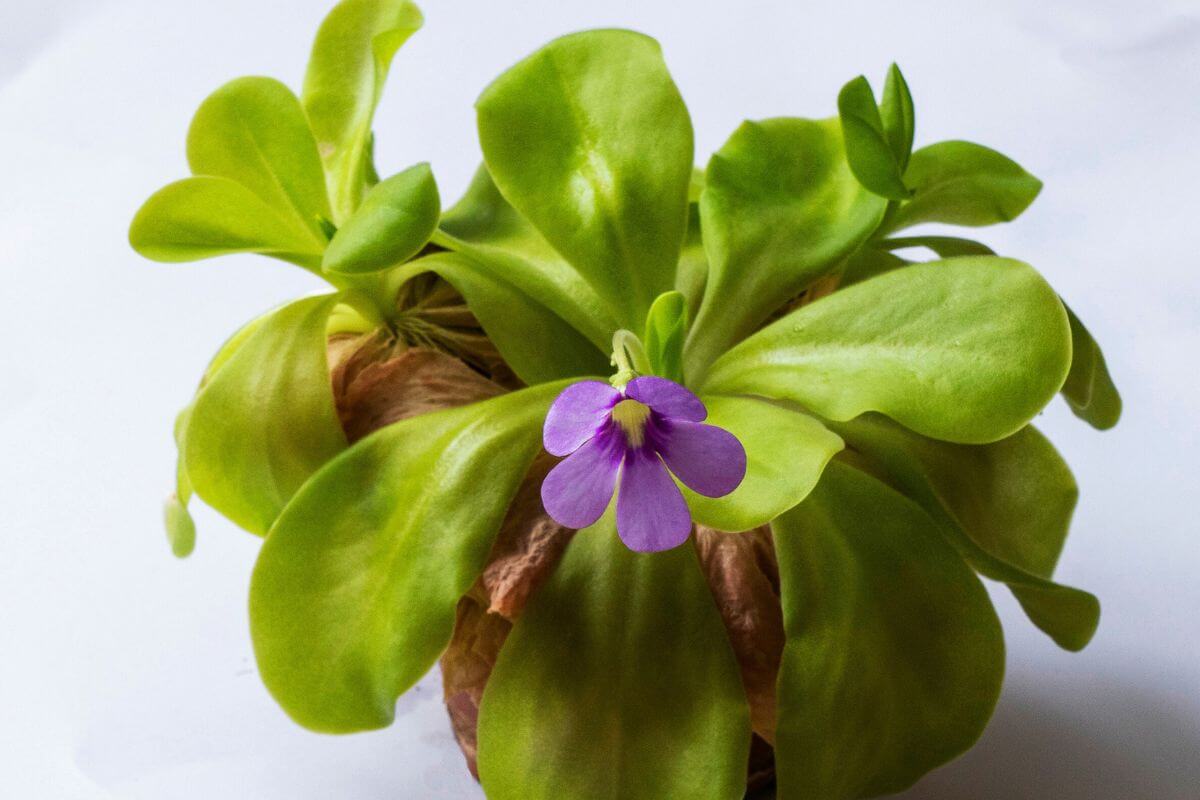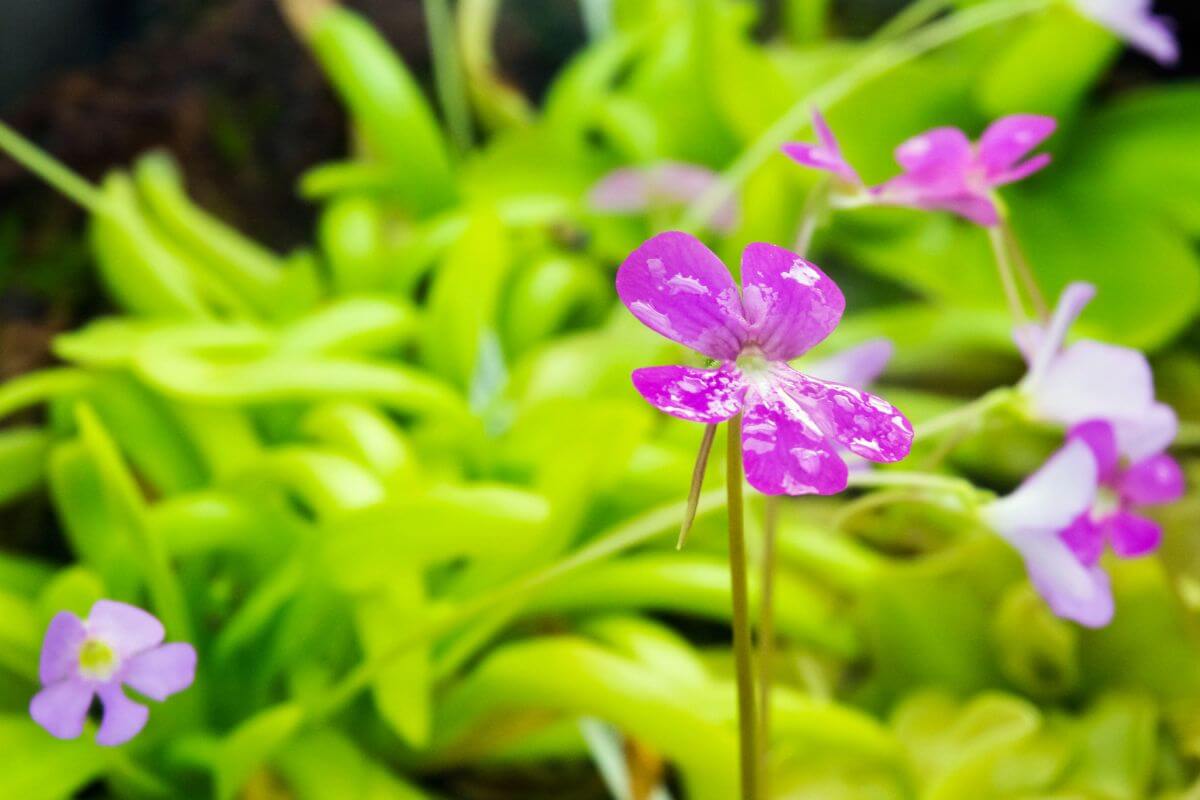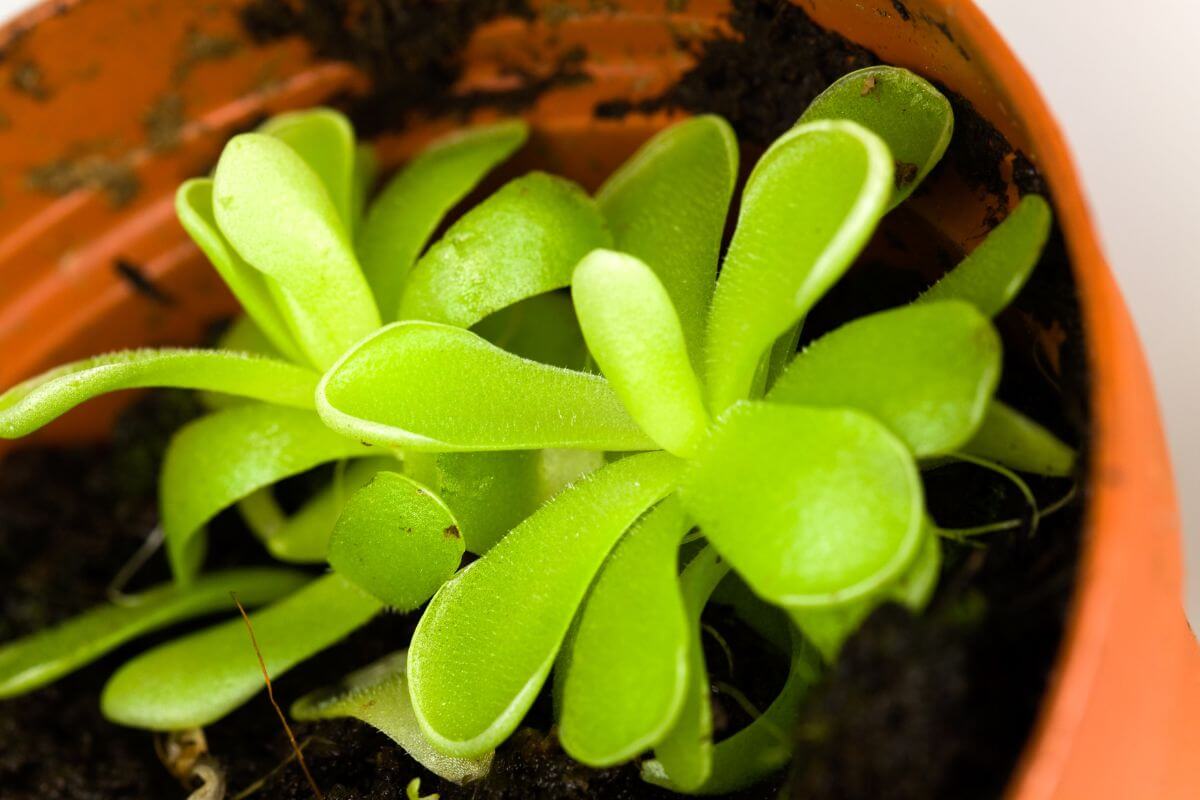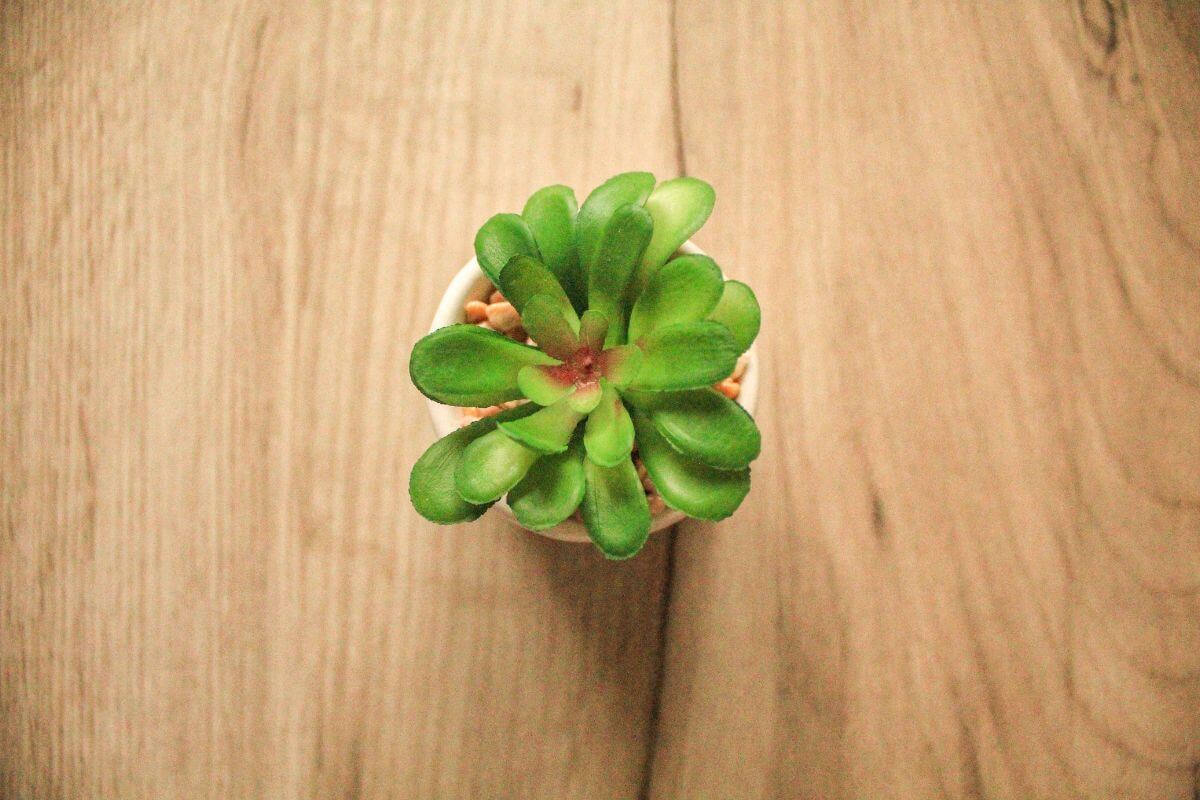Many people like to grow carnivorous plants as houseplants. There are plants like the Venus Flytrap and Pitcher Plants, but the Butterwort Plant is also one to get to know.
The butterwort is not as well known as the other two, but it’s nonetheless a predatory plant that feeds on gnats.
In this guide, learn how to care for the carnivorous butterwort houseplant.
Butterwort Plant Overview

Botanically known as the Pinguicula, and members of the Lentibulariaceae family, butterworts are small plants that can be found underfoot throughout the Southeastern regions of the United States.
Butterworts are a group of carnivorous plants that get their name from the greasy, butter-like appearance of their leaves, which are covered in a sticky secretion that traps insects.
The foliage is yellow-green, and flower blooms may be white, pink, yellow, blue, red, or purple. They may develop into a plant similar to an orchid. The butterwort has no stalks and its carnivorous leaves grow in the form of a rosette.
Its five-petaled flowers last for a considerable amount of time. This succulent plant will flower in the spring and early summer, more or less from May through July.
The genus Pinguicula hosts approximately 80 species with about 13 that are native to Europe and 9 that are native to North America. Several have habitats in northern Asia, and the remaining species are at home in Central and South America.
Popular Pinguicula species include:
- Pinguicula agnata
- Pinguicula ehlersiae
- Pinguicula emarginata (Mexican Butterwort Plant)
- Pinguicula gigantea
- Pinguicula grandiflora
- Pinguicula moranensis
How the Butterwort Plant Catches Insects
The butterwort plant is passive when capturing its prey. It does not use movement to actively catch bugs. Instead, they use a resin coating on its leaves to trap tiny insects once they land on the foliage.
The leaves present a coating of greasy resin that captures prey with its preferred menu being gnats that will provide nitrogen to the plant. The insects will remain stuck in this resin.
As they struggle to free themselves, a digestive enzyme is released by the plant, allowing it to nourish itself with nutrients from the bugs.
Butterwort Plant Care Guide

Environment for the Butterwort Plant
The butterwort is an outdoor plant for areas that are temperate and warm. This is not the ideal plant for indoors unless you can offer a supply of gnats.
While some species are hardy in USDA hardiness zones 3 through 7, others grown in USDA hardy zones 10 and 11 will behave as perennials. In other locations, they may behave as annuals.
The butterwort succulent will tolerate temperatures in a range of 77° to 95° Fahrenheit during the growing season, while the best temperatures during dormancy are between 50° and 65°F.
Growing Medium for the Butterwort
The carnivorous butterwort prefers alkaline soil with few nutrients. Warm, moist, boggy type soil is its ideal home.
Outdoors, these plants require a moist soil bed and can even be located near water. However, wet soil can lead to root rot.
When cultivating indoors, you will have several choices of growing medium.
- Use a mix of sphagnum moss and sand in equal parts. Vermiculite can also be used instead of sand.
- Peat moss can be combined with sand or perlite in a 50/50 ratio.
- An orchid potting mix of pumice, bark, and perlite for the bottom half of the container and the top half filled with sphagnum moss. In this case, your container can sit in a water saucer or tray constantly.
- Rocks and live moss. Rocks of granite, limestone, perlite, or pumice can establish a natural landscape for your butterwort. You can integrate this with live moss placed on the rocks. The butterwort may grow on the rocks or directly on the moss. In this case, the rock container should sit in a water tray to ensure moisture levels and humidity should be measured at a minimum of 50%.
Light for the Butterwort
The butterwort prefers full morning sun but will thrive in an environment offering sun to partial shade, especially during the hotter moments of the day.
East and west-facing windows are best for the butterwort when grown indoors.
Water for the Butterwort
Water and its quality are very important to the survival of the butterwort. The drying out of this plant or its soil bed will be fatal.
This plant also exhibits sensitivity to some minerals and salts, so collected rainwater or the use of distilled water is recommended. Avoid tap water if possible, because it can contain minerals like chlorine that can harm plants. It depends on how clean the tap water is in your area.
Also, avoid top watering unless necessary as it will wet the leaves and eventually may lead to leaf rot. Better to water the soil bed around the base of the plant directly.
When cultivated indoors, the pot should have good drainage even if it needs to remain constantly moistened.
Higher humidity levels are typical of the plant’s natural habitat, however, if the roots are kept continuously moist, a lower humidity level should not negatively influence your plant’s growth and health.
Fertilizer for the Butterwort

As carnivorous plants, the butterwort does not require fertilizer and may even have an adverse reaction if fertilized.
That’s a nice advantage of not needing to worry about feedings.
Pruning and Repotting the Butterwort
The butterwort does not require much in the way of pruning, simply remove any offsets when preferable.
Outdoor plants should be transplanted annually or every second year in March based on growth. Container plants can be transplanted annually.
Propagating the Butterwort
In the butterwort’s natural habitat, pollinators help the plant to spread, especially the hummingbird. However, this plant can be propagated by using leaf cuttings, seeds, or division.
To propagate with seeds, place the seeds on moist soil in a container. Avoid burying them, instead choosing to sow them on the top of the soil bed.
Allow the seeds to germinate for a few weeks in a location with high humidity and temperatures between 60° and 80°F. When plantlets appear, these can be transplanted into individual containers.
To propagate with leaf cuttings, pull an outside leaf from the base and place it in pure peat. Place it in an area with higher humidity and wait until roots develop. This should be done during the winter when the plant is dormant.
Should you decide to propagate using the division of offsets, again divide your butterwort in the winter during dormancy.
Butterwort Pests, Diseases, and Problems

Houseplant pests do not present a particular threat to the butterwort because it is carnivorous. Some commercial plant producers even use carnivorous plants for pest control.
Butterworts are generally free of disease but may be subject to root rot if the soil bed does not drain adequately.
Butterwort Toxicity and Pets
Carnivorous plants are not known to be toxic to dogs or cats.
Butterwort Care Final Thought
If you hate bugs, love flowers, and are intrigued at the thought of cultivating a carnivorous plant, the butterwort may be the perfect fit.
It is an easy-care plant with low maintenance as it only needs light and water. So, if you are new to cultivating carnivorous plants, the butterwort is a perfect beginner plant.
Here are plant care guides for carnivorous plants and other houseplants:
- Sundew Plant Guide
- Venus Flytrap Guide
- Pitcher Plant Guide
- Purple Passion Plant Guide
- China Doll Plant Guide
Butterwort Plant Care FAQs
How do you take care of a butterwort plant?
Take care of a butterwort plant by making sure it gets lots of sunlight and water. Make sure it gets well-draining soil, but keep it moist. Use potting mix made up mostly of perlite and vermiculite. You can add some sand to keep drainage good.
What kind of light will my butterwort need?
The butterwort likes lots of sunlight. A bright window sill provides enough sunlight for most indoor plants. But, keep in mind that some species prefer more direct sun than others. If the temperatures are particularly hot, above 95°F, then be sure it gets partial shade too.
Where can I find butterwort plants?
You can find butterwort plants online through Amazon.com or any number of specialty nurseries. They also sell seedlings directly from their websites. Check your local nurseries and garden centers to see if they sell butterworts.
What do butterwort plants eat?
Butterwort plants like to eat insects such as aphids, mites, mealybugs, scale insects, spider mites, whiteflies, thrips, beetles, ants, earwigs, cockroaches, crickets, grasshoppers, flies, wasps, bees, butterflies, spiders, centipedes, millipedes, slugs, snails, worms, caterpillars, and many types of fungi. Butterwort plants have been shown to consume over 100 different kinds of insect prey.
What does a butterwort look like?
The butterwort plant’s leaves are yellow-green. When the flowers bloom, they are in a variety of colors like purple, white, yellow, pink, red, or blue. It has no stalk and the leaves form a rosette together.
How long do butterwort flowers last?
Butterwort flowers will last about 2 to 3 weeks after blooming before wilting. The flower petals fall off naturally when the time comes.
Why is my butterwort plant dying?
Your butterwort plant could be dying because there isn’t enough food available for its roots. This happens when the soil dries out. Try adding some peat moss to help retain moisture. Also, make sure that the soil drains properly so that excess water doesn’t sit on top of the soil.
How do butterworts catch prey?
Butterwort plants catch their prey using sticky hairs called trichomes. These hairs trap small animals and hold them until the plant digests them. Some people call these hairy traps “suction cups.” Butterwort plants sit still and wait for prey to come near to trap the bugs. Once trapped, the animal becomes stuck to the leaf surface where it eventually dies.


